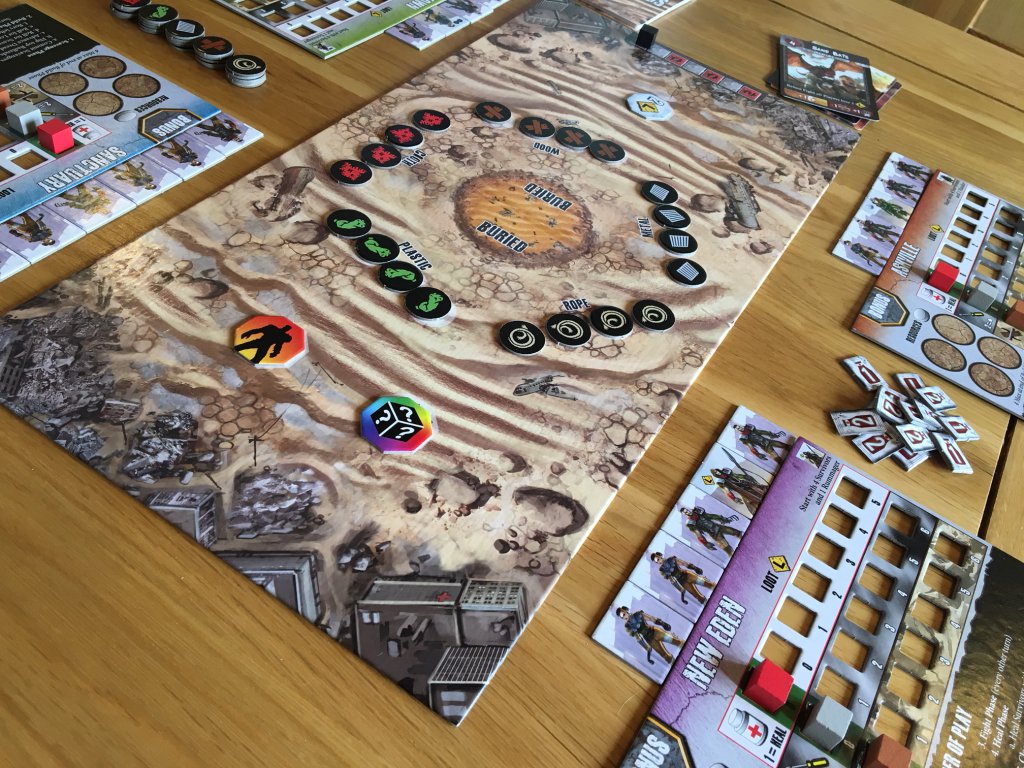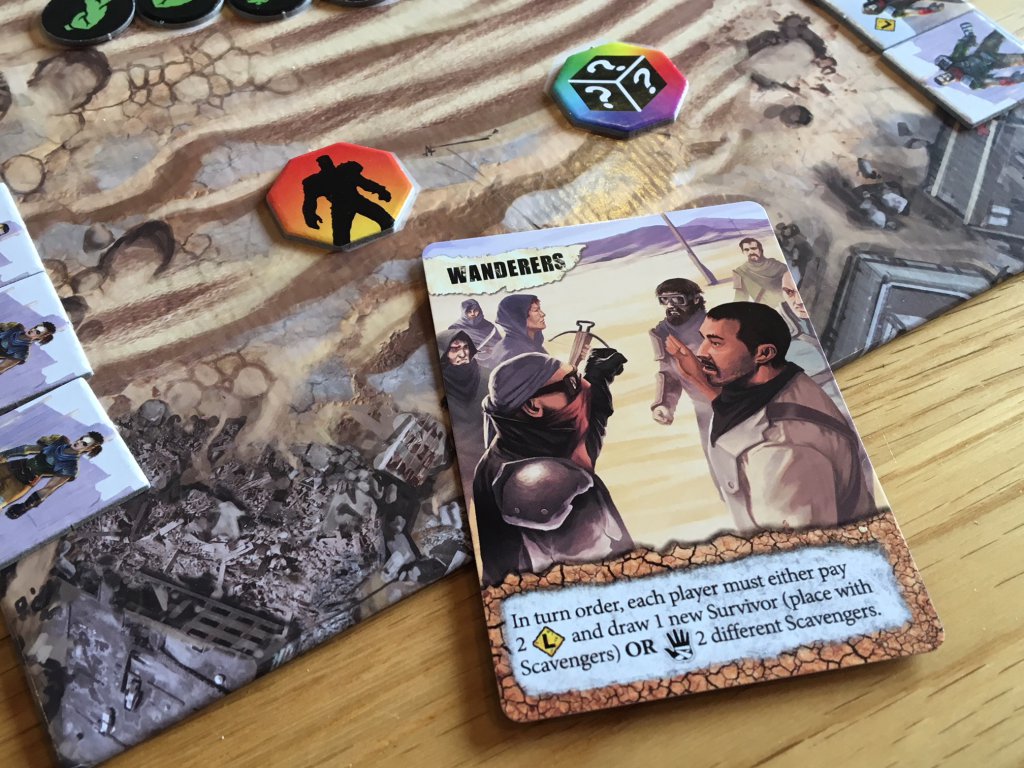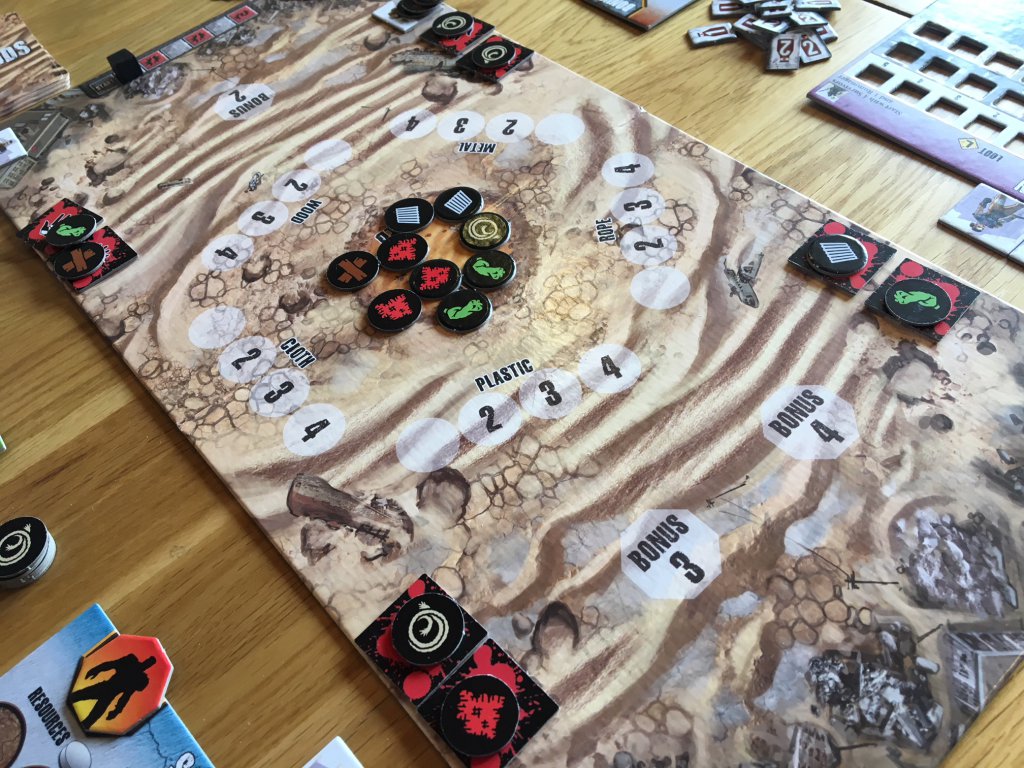Remnants review — Wasteland shakedown
Introduction
Inspired by Mad Max, Fallout and all the other popular interpretations of what might happen in a post-apocalyptic world, Remnants takes the usually serious subject of survivalism and injects some much-needed chaos and mayhem into the mix. With real-time dice rolling, fast-paced resource gathering and competitive card selection (sort of like drafting), Remnants mixes a lot of ideas together, which are often successful, especially when your group gets into the swing of things. Real-time games polarise opinion, however, so is Remnants for you? Keep reading to find out.
Overview
In Remnants, each player takes the role of an individual faction or enclave, each of which has a slightly different mix of survivor tokens at the beginning of the game. These factions then compete for resources by sending a number of their survivors into the wasteland or city areas of the board in the hope that they will recover resources of various kinds. The players need these resources to purchase cards from a common area — these could strengthen their base, add to their ability to generate resources automatically or allow them to attack hostile forces.
On that note, players don’t attack each other directly. Instead, Remnants features a countdown tracker that spawns enemies — who attack each enclave in turn — from a deck built at the beginning of the game. The factions that fail to protect themselves or mount an adequate offense will be damaged and potentially suffer penalties, which might wound or kill their survivors, among other things. Remnants is the kind of game where you never have quite everything you need, so maximising the efficiency of each move is paramount — but the real-time gathering mechanics make it hard to focus on what matters.
Ultimately, the winner is the player who can amass the most victory points as a result of their various endeavors in the wasteland after six rounds, assuming they survive at all. Actually, that’s not true — there is no player elimination in Remnants, but it is possible for players to have their force of survivors diminished to the extent that they are basically no longer able to compete. Remnants kind of combats this by offering minor benefits to the player who fails to collect resources, but nothing makes up for being able to throw bodies at the problem.
Survivors come in two different kinds, ranging from vanillas (who have no specific strength) to specialists in a number of areas. These specialists can, for example, bring back two resources instead of one, or automatically succeed when searching a city. Effectively, they provide small bonuses to the standard functions of the game, without ever breaking the rules in a way that feels overpowered. Players must invest in specialists to obtain more of them, but it’s almost always worth doing so in order to reap the benefits.
Components
Now, like the other Fireside Game I’ve reviewed (Hotshots) and the upcoming one I am yet to write about (Kaiju Crush), Remnants is well produced, albeit with a particular price point in mind. The game includes a nicely illustrated central board, a number of card decks and an absolute boatload of tokens to represent various resources. There is also a player board for each faction and a number of tokens to slot nicely into them.
These components are effectively laid out on the table as two separate areas. Firstly, there’s the main board itself, which is surrounded by cards and pieces that logically relate to it and include most of the tokens, the cards that represent the available supply of survivors, the boss cards and a few other bits and pieces. The second area contains each of the three face-down decks of development cards (ranging from level one to three), including a row of three currently available cards spanning out from each deck, which shows what cards are available to purchase (nine in total).
As I mentioned earlier, all the components in Remnants are built to a standard that meets the smaller-box, sensible-price-point approach Fireside Games have adopted across their range. What that means (to me, at least) is that where another publisher might use miniatures to represent the survivors or wooden pieces for resources, Fireside sensibly use bright and easily identifiable tokens — perfectly functional, but not as exciting. They’ve spared no expense on the custom dice, however, There are four per player (a total of sixteen).
Overall, Remnants offers an attractive and intriguing board presence which is eye catching enough to draw in new players, especially once the frenzied clattering of dice begins to cause a ruckus. If I had one complaint, I’d suggest that it is probably related to the way in which survivors are placed in a fairly nondescript way alongside the edge of the board, indicating which are in the wasteland or city zones. The problem is that these zones are not clearly marked and there is little room to fit survivors alongside each other. In the chaos of throwing dice (which leads to board knocking etc.) they tend to merge together, which can result in a bit of refereeing.
Turn structure
You can break Remnants down into five distinct phases, each of which is performed by the players at the same time (albeit with turn order affecting some of them). First among them is the Scavenge phase, which involves committing survivors and specialists to scavenging and looting. Once players have decided how many survivors and specialists to place, they draw a Badlands card — this represents the unknown nature of heading out into the wastes and will almost always have a negative effect. Next, the Dread Track (or turn tracker) is advanced one space, which indicates whether there will or won’t be a fight phase later in the turn.
Bearing in mind that we are still in the Scavenge phase — we must now actually do the scavenging. This is all about real-time dice throwing, which is arguably the defining element within Remnants. This means players either love it or hate it. Anyone who has committed a scavenger rolls their four dice, re-rolling as many (or as few) dice as they like in an attempt to get three of a kind. If the dice show a resource they want, they shout it out (for example, ‘metal’) and grab a matching token from either the desert or buried areas. This continues until all bonus tokens have been claimed (for rolling three stars) and there is always one fewer bonus than there are players.
Next up, players roll for looting (I mentioned earlier how scavengers go into the wasteland and looters go into the city). For each looter committed to the city, players roll a die. Instead of looking at the resource shown on the die, they instead total the number of pips shown across all dice, then add medicine, screwdrivers and scrap to their player board equal to the total rolled (in any combination). Medicine is used to heal survivors, screwdrivers add one to rolls involving pips (either looting or fighting) whilst two scrap can be converted into any one resource.
After removing all the resource tokens, retrieving dice and survivors and having a general tidy up, players begin the Build phase. In turn order, they may buy development cards or recruit and upgrade survivors, taking it in turns to make one purchase, then passing until no one can (or wants to) spend more. It’s uncommon for players to pass rather than invest, however, as on every other turn, players need to resolve a Fight phase, which can be extremely damaging to those who are unprepared.
During the Fight phase, everyone must face the current, face-up Dread card one by one. To do so, players total up the number of defense symbols available to them across all the Development cards they’ve purchased. Each of these symbols deducts one health from the attacking Dread card. They then roll dice equal to the number of fist symbols across their cards, with each pip shown (or paid for by screwdrivers) resulting in one further hit on the Dread card. If the cumulative effect reduces the Dread card to zero, the player wins and may claim victory points. Defense points alone can deflect the attack, but never result in a win — which seems fair.
There is a final boss fight which, like the Dread cards, issemi-randomisedd, albeit from a very small deck. Bosses actually come with a neat twist in the form of an unknown upgrade (such as body armour) to make them even tougher. After the fight (boss or otherwise), players may heal their survivors using medicine, then perform cleanup actions such as moving remaining resources from the desert into the buried pile. After the boss battle, final scoring takes place. I won’t go into detail here, but players will already have many points in hand as the result of their in-game exploits, but they’ll also score uninjured survivors and specialists, plus relevant Development cards.
Game experience
Whilst overall, I quite like Remnants, it does have a few rough edges. Firstly, it’s a good-looking game when laid out on the table, with lots of unique-looking cards and tokens, plus the unusual board. It also has the raucous, real-time game play I mentioned earlier, which always attracts a crowd should you find yourself playing at an expo or with a large gaming group that runs multiple different games at the same time.
The manual indicates quite a large number of relatively fiddly rules, but Remnants actually has a very logical flow to it, once you understand how to set it up and how each of the phases plays out. For example, one of the main reasons to play Remnants is because you’ll see the Development Cards and want to build them. Why? Because you can imagine fortifying your own base and defending it from the incoming Dread cards. How do you do it? Well, it’s obvious that collecting resources is the way and it’s just as obvious that in this world, you’ll need to send people out into the treacherous wasteland to scavenge.
Now the actual gathering bit is a hit-and-miss experience for me, but only because I am not the world’s biggest fan of real-time dice rolling. I feel a bit like compounding luck-based actions with dexterity/speed in a pressure cooker of decision making is a bit of a hard sell, but then again, that could just be me. Most people who played the game enjoyed it and we also largely agreed that the outcome of the dice-rolling part of Remnants is rarely that cutthroat — is relatively uncommon for a player to be locked out of a particular resource, although it is possible for the Scavenge phase to end before a player has collected a resource for every scavenger.
Whilst much simpler to resolve, I am not absolutely convinced by the relevance of the looting feature. I think medicine is important, but screwdrivers and scrap seem a little underpowered. On the plus side, there are a number of tactical approaches that a player can take in Remnants, so perhaps I am playing it sub-optimally. Similarly, I also felt like there was little incentive to upgrade survivors into specialists or even buy new survivors, because whilst injury is fairly frequent, it’s usually possible to keep people alive. I think with a lower number of starting survivors and perhaps a couple more turns to build up, this would be a different story.
I really enjoyed the manner in which the Dread card deck is built randomly and especially the way the boss will always have an additional, unknown power-up. If I were being negative, I’d probably suggest that a few more Dread card options, as well as more Badlands cards and bonus tokens in the base game, could really enhance replayability — but it’s not a big deal. That desire is actually born from the fact that I found the basic gameplay loop in Remnants very enjoyable.
Conclusion
Ultimately, there is a lot to like about Remnants. If it is released at the same reasonable MSRP most Fireside Games launch at, it will also be very cost effective relative to the rich experience it offers. Whilst no individual element of Remnants is unique, it does assemble a number of immediately familiar, thematic systems together under a banner that makes sense. Sure, not everyone will love the real-time dice rolling and I guess that more of the most interesting, variable components would have been nice, but Fireside have once again come up with a fun and highly repeatable game.
A copy of Remnants was provided for review purposes. You can find out more about Remnants on the website of publisher Fireside Games.






Comments are closed.